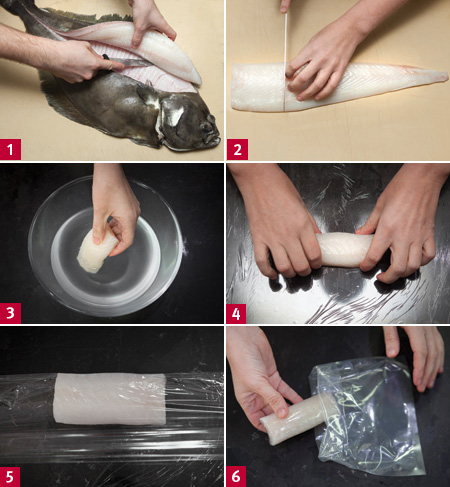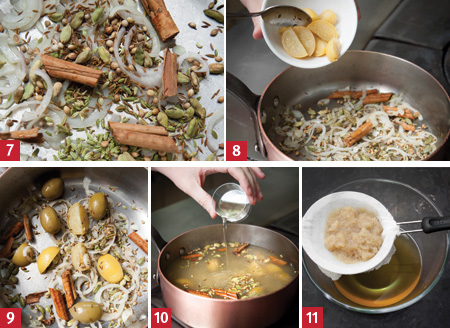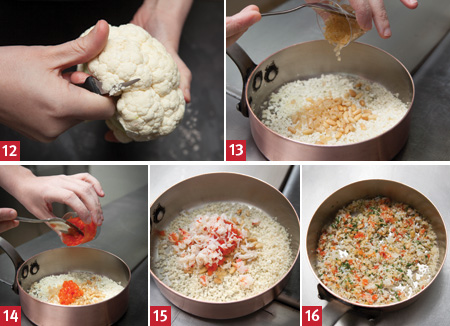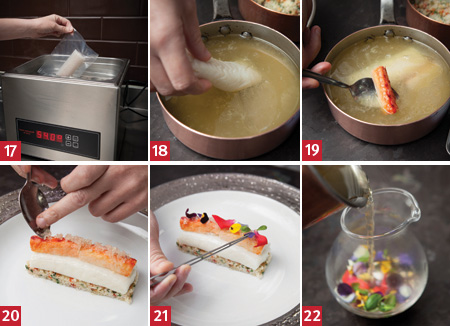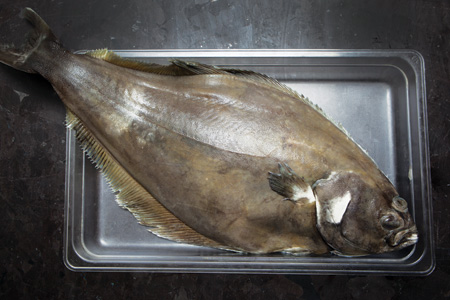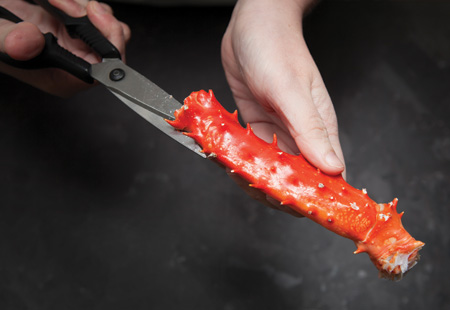Chef masterclass: Isle of Gigha halibut by Clare Smyth
At Restaurant Gordon Ramsay in Royal Hospital Road, Chelsea, chef-patron Clare Smyth creates a refined and beautiful halibut dish. Michael Raffael reports
He left, and Gordon Ramsay, who was 31 at the time, bought the premises. It was a brave but inspired choice. He too won Michelin's top accolade and, in Ramsay's case, his undoubted talent in the kitchen acted as a stepping stone to creating himself as a global brand.
In 2007, Clare Smyth became Ramsay's head chef at Royal Hospital Road. Six years later, while keeping her mentor's name above the door, she took over as its chef-patron. Her way of cooking is quite different to what either Koffmann or Ramsay would have favoured. It's not just the techniques and the science that have altered; the ingredients and the breadth of knowledge have also expanded. Farmed halibut, for example, didn't exist a generation ago - if it had, starred chefs might have sniffed at it. Water baths, even when called sous-vide, were in their infancy.
The complexities and refinements of modern dishes have become the building blocks of a contemporary chef's craft. Today's stars have a duty to challenge the accepted wisdom passed down to them. It's a role they've embraced. The skills and imagination of chefs like Smyth have taken cooking up a notch. Top-of-the-tree dining hasn't just grown more interesting - its quality is more rigorous and consistent, too.
Planning
Halibut is on two menus at Royal Hospital Road: Á la carte and Prestige. The whole fish is prepared daily, based on the day's deliveries. Ahead of each service the team fillets and portions the halibut, brines it, clingfilms it to set the shape, and vacuum-packs it. When an order comes in, it's cooked in a water bath, unwrapped and finally simmered in a flavoured nage.
Making the tagine broth is a two-day process. On day one, the broth base is simmered, chilled and frozen. It is then defrosted over muslin for 24 hours, which filters and clarifies it.
Preparing the cauliflower couscous is a combination of basic mise en place and finishing to order.
Yield and costing
A 6kg halibut costs the restaurant around £130. Setting aside trimmings, it yields four skinned fillets (the dark-skinned ones on top are thicker) that weigh about 2.5kg. It's served in 120g portions on the Á la carte menu (£95 for three courses) and in 60g portions on the Prestige menu (£135 for seven dishes).
Halibut preparation
Treat the fish like a large lemon sole or brill. Lift the fillets in the usual way. Cut down the backbone. Keep the knife-blade against the bone and free the four fillets (1). Skin them in the usual way.
When portioning reserve the tail-end of the fish for the tasting menu or similar portions. Cut pavés from the thick end, weighing about 130g each (2). Trim to form perfect rectangles.
Prepare a 10% brine (10g salt dissolved in 100ml water). Brine the portions of fish: seven minutes for pavés and five minutes for smaller portions (3). Drain and pat dry.
Wrap each portion of fish in two layers of film so it forms a regular shape (4-5). Put each one in a vacuum-pack bag and seal at 75% pressure (120 bar) (6). Set aside until service.
An optional technique is to brush the film with oil to prevent any risk of it sticking.
Tagine broth
The recipe derives from a fish tagine Smyth sampled in Morocco. She worked at the flavour profile and then incorporated it into a filtered broth. Freezing and then defrosting it over muslin improves on the traditional clarification process, done with egg white.
For the restaurant she would normally work with 10-litre batches frozen in gastronorm trays. For these photos she prepared a scaled-down quantity. The following recipe is based on 500ml light chicken stock.
- 1tbs olive oil
- 2tbs finely sliced shallots
- 1tsp (heaped) cumin seeds
- 1 scant teaspoon each green cardamoms, toasted pine kernels, coriander seeds, fennel seeds, white peppercorns, nutmeg
- 5cm cinnamon stick
- 2tbs quartered Moroccan preserved lemon
- 2tbs whole green olives
- 500ml chicken stock
- 1tbs preserved lemon brine
- 1tbs green olive brine
Warm the oil in a pan large enough to take all the ingredients. Sweat the shallots without colouring. Bruise the spices and add them to the pan (7) and cook until fragrant. Add the lemon, olives, stock and brine (8-10). Simmer for 30-40 minutes, taking care not to reduce the broth (top up if necessary).
Strain the broth through muslin and freeze. Defrost it over muslin, allowing it to drip for 24 hours over a bowl without touching it (11).
Cauliflower couscous
Cauliflower 'couscous' owes its existence to the creative imagination of Ferran AdriÁ and it is well on the way to becoming a classic of the modern repertoire. At Restaurant Gordon Ramsay it's been adapted and taken to a new level. The grain texture echoes the taste of the tagine-inspired broth.
The kitchen prepares the cauliflower ahead of each service, but finishes each portion to order. To make the couscous, use a very sharp vegetable prep knife and shave the ends off the florets on a cauliflower (12). Allow about 50g couscous per portion. A cauliflower weighing about 1kg will yield enough for eight portions.
Serves 1
- 10ml olive oil
- 40-50g cauliflower couscous
- 1tsp red pepper, blowtorched, skinned and diced
- 1tsp finely diced preserved lemon peel
- 1tsp toasted pine kernels
- 1-2tsp diced king crabmeat
- Chopped coriander
- Salt
- 1-2tsp emulsified vinaigrette (1 part Champagne vinegar: 4 parts olive oil)
Heat the oil in a small pan. Sauté the cauliflower for about a minute. Stir in the other ingredients (13-16).
Isle of Gigha halibut with Atlantic king crab, cauliflower couscous, finger lime and ras el hanout-infused broth
Serves 1
- 120g prepped portion halibut
- 500ml vegetable nage
- 60g approx. prepped cauliflower couscous
- 100ml prepped tagine broth
- 1-2 drops rosewater
- Seasonal flower petals including rose petals
- 1 x 7cm piece of cooked crab leg
- 1 scant tsp finger lime (skinned and seeded)
- Baby basil and coriander leaves
Preheat the water bath to 54°C. Poach the halibut for 12 minutes (17). Remove from the vac-pack and film.
Heat the nage to 65°C. Before plating, heat the halibut in the nage for one minute (18), drain and pat dry (19).
To plate: use a rectangular mould the size of the halibut. Put it in the centre of a flat- bottomed bowl. Spoon the warm couscous into it and flatten slightly. Lay the fish on this bed and remove the mould.
Heat the tagine broth so it's hot but not boiling. Add the drops of rosewater and stir in the flower petals. Transfer to a transparent jug.
Place the crab on the halibut. Decorate with finger lime beads (20), flower petals and the baby leaves (21). Serve and pour the tagine broth at the table.
Note: Clare Smyth adds a little Champagne vinegar vinaigrette to the nage to add a touch of acidity (22).
Gigha halibut
Winner of the 2014 BBC Food and Farming Award for Best Producer, organic Gigha halibut, farmed in the Western Highlands, ticks the boxes most chefs will have in mind when ordering fish. It's slow-grown -about four-and-a-half years old before it reaches maturity; it's sustainable - wild Atlantic halibut has been over-fished and is now endangered, according to the Marine Conservation Society (which recommends chefs use organic farmed halibut instead); and it's still sufficiently exotic to have a luxury image. It has perfect white flesh, a distinctive flavour and a soft but dense texture.
www.gighahalibut.co.uk
Preserved lemons
Restaurant Gordon Ramsay preserves untreated baby lemons in a pickle flavoured with star anise and cinnamon for a minimum of six months. It uses the diced pulp and a little brine for the tagine broth and a brunoise of the peel for the cauliflower couscous.
Atlantic crab
The large, ready cooked king crabs used in the recipe have legs containing meat that are ideal for the presentation of the dish. To extract the meat from the shell, cut through the leg shells with kitchen shears to expose the white crabmeat and remove it in a single piece. Extract and reserve other crabmeat for mixing into the cauliflower couscous.
Clare Smyth
Born in Northern Ireland, Smyth grew up on a farm in County Antrim and moved to England at 16 to learn the skills that would eventually make her a world-class, three-Michelin-starred chef. On completing her studies, her thirst for knowledge drove her to work and stage under many influential chefs around the world.
In 2002 Smyth joined Restaurant Gordon Ramsay and worked her way up the ranks to become senior sous chef. Smyth left London in 2005 to join the kitchen at Alain Ducasse's renowned Le Louis XV in Monte Carlo. In 2007 she returned to Restaurant Gordon Ramsay as head chef aged just 29, and in 2012 became chef-patron.
In 2013, Smyth was made an MBE for services to the hospitality industry, and she supports a range of charities including Action Against Hunger and The Gordon Ramsay Foundation. She is also a patron of HemiHelp.
The Good Food Guide awarded Smyth Chef of the Year in 2013 and she and her team achieved a perfect 10/10 score in 2014, one of just three restaurants to receive such acclaim in Britain.
"What looks simple on a plate may involve a lot of work, but the customer should never see the complications." Smyth couldn't be clearer. At the highest level, chefs shouldn't make those who eat their food work too hard to enjoy it.
It's a thoughtful response from a chef-patron who believes that the profession itself has changed its character. It isn't just the pressure of media coverage on restaurants in the spotlight that has altered. Competition at the top is fierce and the dining-out public's expectations have risen.
"People eat out all over the world; they have more disposable income and they are more educated," she says. For those with means, eating out is a routine experience rather than a special occasion.
Her message is an antidote to aspiring superstar chefs. Around the world there are hundreds of three- and two-star experiences for the public to choose from.
"If you are not going to execute your food well," she insists, "you are not going to last."
To reach the highest level, she believes, the learning process is growing ever more demanding: "You have to pass through a lot of kitchens, learn a lot of techniques. You have to invest in your own education. It takes years of experience. Doing the same thing hundreds of times: turning an artichoke or filleting a fish gives you the tools to become a really good chef. Mastering the skills, mastering the trade isn't something that happens in five minutes."
Turning experience into a level of craftsmanship, she argues, is one thing, but developing a unique personal style is different. "When I first became a head chef, I thought I was expressing myself, but I wasn't. I was just cooking food I'd learned from other chefs. Over time though, you start to evolve your own personal identity. You have an idea and you have the tools to execute it."
Using the armoury of kitchen equipment is a necessity, but understanding what happens during cooking processes is more so: "When I worked for Alain Ducasse, yes we had water baths, but we never talked about it. What mattered was knowing how to cook properly without them."
That organic approach to her career also goes a way to explaining how she shifted from being Gordon Ramsay's head chef to the restaurant's boss. "I was going to open my own place," she says "and Gordon was going to back me, but he said that the guests were coming here to eat my food - why change it? He wanted to keep that together. So it was a totally natural evolution."
This raises the question of what's going to happen in the future? "Nothing," she insists, "is going to happen in five minutes." A book and a new kitchen are in the pipeline, but for the moment she doesn't plan to follow the Ramsay lead and open a string of her own restaurants - but she doesn't rule that out either.
Her main objective has always been to ensure that her customers have a great time, and all the pressures of running her own business are directed towards that goal. The times that give her the most satisfaction are when she has created a successful new dish to add to her repertoire. "I'm first and foremost a chef, happiest when I'm in the kitchen, knowing that I'm making guests happy too. That's something real, that's tangible," she says.
Photos by Lisa Barber www.lisabarber.co.uk



